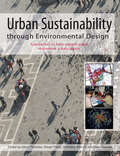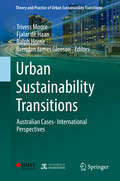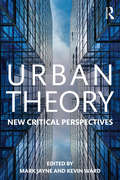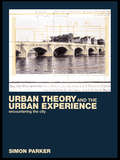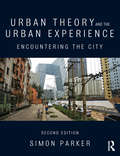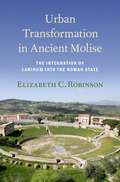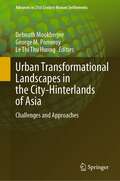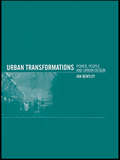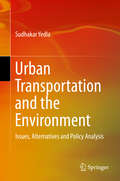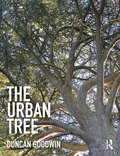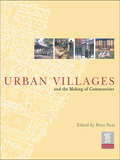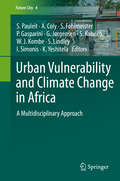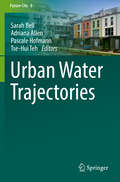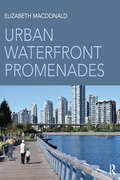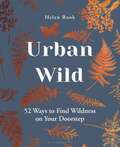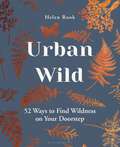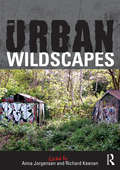- Table View
- List View
Urban Sustainability Through Environmental Design: Approaches to Time-People-Place Responsive Urban Spaces
by Kevin Thwaites Sergio Porta Ombretta Romice Mark GreavesWhat can architects, landscape architects and urban designers do to make urban open spaces, streets and squares, more responsive, lively and safe? Urban Sustainability through Environmental Design answers this question by providing the analytical tools and practical methodologies that can be employed for sustainable solutions to the design and management of urban environments. The book calls into question the capability of ‘quick-fix’ development solutions to provide the establishment of fixed communities and suggests a more time-conscious and evolutionary approach. This is the first significant book to draw together a pan-European view on sustainable urban design with a specific focus on social sustainability. It presents an innovative approach that focuses on the tools of urban analysis rather than the interventions themselves. With its practical approach and wide-ranging discussion, this book will appeal to all those involved in producing communities and spaces for sustainable living, from students to academics through to decision makers and professional leaders.
Urban Sustainability Transitions: Australian Cases- International Perspectives (Theory and Practice of Urban Sustainability Transitions)
by Trivess Moore Fjalar De Haan Ralph Horne Brendan James GleesonThis book contributes to current debates regarding purposive transitions to sustainable cities, providing an accessible but critical exploration of sustainability transitions in urban settings. We have now entered the urban century, which is not without its own challenges, as discussed in the preceding book of this series. Urbanization is accompanied by a myriad of complex and overlapping environmental, social and governance challenges – which increasingly call into question conventional, market-based responses and simple top-down government interventions. Faced with these challenges, urban practitioners and scholars alike are interested in promoting purposive transitions to sustainable cities. The chapters in this volume contribute to the growing body of literature on city-scale transformative change, which seeks to address a lack of consideration for spatial and urban governance dimensions in sustainability transitions studies, and expand on the basis established in the preceding book. Drawing on a range of perspectives and written by leading Australian and international urban researchers, the chapters explore contemporary cases from Australia and locate them within the international context. Australia is on the one hand representative of many OECD countries, while on the other possessing a number of unique attributes that may serve to highlight issues and potentials internationally. Australia is a highly urbanized country and because of the federal political structure and the large distances, the five largest state-capital cities have a relatively high degree of autonomy in governance – even dominating the rest of their respective states and rural hinterlands to a certain extent. This context suggests that Australian cases can provide interesting “test-tube” perspectives on processes relevant to urban sustainability transitions worldwide. This volume presents an extensive overview of theories, concepts, approaches and practical examples informed by sustainability transitions thinking, offering a unique resource for all urban practitioners and scholars who want to understand and transition to sustainable urban futures.
Urban Theory: New critical perspectives
by Mark Jayne Kevin WardUrban Theory: New Critical Perspectives provides an introduction to innovative critical contributions to the field of urban studies. Chapters offer easily accessible and digestible reviews, and as a reference text Urban Theory is a comprehensive and integrated primer which covers topics necessary for a full understanding of recent theoretical engagements with cities. The introduction outlines the development of urban theory over the past two hundred years and discusses significant theoretical, methodological and empirical challenges facing the field of urban studies in the context of an increasing globally inter-connected world. The chapters explore twenty-four topics, which are new additions to the urban theoretical debate, highlighting their relationship to long established concerns that continue to have intellectual purchase, and which also engage with rich new and emerging avenues for debate. Each chapter considers the genealogy of the topic at hand and also includes case studies which explain key terms or provide empirical examples to guide the reader to a better understanding of how theory adds to our understanding of the complexities of urban life. This book offers a critical and assessable introduction to original and groundbreaking urban theory and will be essential reading for undergraduate and postgraduate students in human geography, sociology, anthropology, cultural studies, economics, planning, political science and urban studies.
Urban Theory: New critical perspectives
by Mark Jayne Kevin WardUrban Theory: New Critical Perspectives provides an introduction to innovative critical contributions to the field of urban studies. Chapters offer easily accessible and digestible reviews, and as a reference text Urban Theory is a comprehensive and integrated primer which covers topics necessary for a full understanding of recent theoretical engagements with cities. The introduction outlines the development of urban theory over the past two hundred years and discusses significant theoretical, methodological and empirical challenges facing the field of urban studies in the context of an increasing globally inter-connected world. The chapters explore twenty-four topics, which are new additions to the urban theoretical debate, highlighting their relationship to long established concerns that continue to have intellectual purchase, and which also engage with rich new and emerging avenues for debate. Each chapter considers the genealogy of the topic at hand and also includes case studies which explain key terms or provide empirical examples to guide the reader to a better understanding of how theory adds to our understanding of the complexities of urban life. This book offers a critical and assessable introduction to original and groundbreaking urban theory and will be essential reading for undergraduate and postgraduate students in human geography, sociology, anthropology, cultural studies, economics, planning, political science and urban studies.
Urban Theory and the Urban Experience: Encountering the City
by Simon ParkerFor the first time Urban Theory and the Urban Experience brings together classic and contemporary approaches to urban research in order to reveal the intellectual origins of urban studies, and the often unacknowledged debt that empirical and theoretical perspectives on the city owe to one another. Both students and urban scholars will appreciate the critical way in which classical and contemporary debates on the nature of the city are presented. Extensive use is made throughout of documentary, literary and cultural sources to bring the different theoretical perspectives to life. Discussion points introduce and explain key concepts and intellectual histories in a jargon free manner. End of chapter further readings have also been annotated to encourage additional study.
Urban Theory and the Urban Experience: Encountering the City
by Simon ParkerFor the first time Urban Theory and the Urban Experience brings together classic and contemporary approaches to urban research in order to reveal the intellectual origins of urban studies, and the often unacknowledged debt that empirical and theoretical perspectives on the city owe to one another. Both students and urban scholars will appreciate the critical way in which classical and contemporary debates on the nature of the city are presented. Extensive use is made throughout of documentary, literary and cultural sources to bring the different theoretical perspectives to life. Discussion points introduce and explain key concepts and intellectual histories in a jargon free manner. End of chapter further readings have also been annotated to encourage additional study.
Urban Theory and the Urban Experience: Encountering the City
by Simon ParkerUrban Theory and the Urban Experience brings together classic and contemporary approaches to urban research in order to reveal the intellectual origins of urban studies and the often unacknowledged debt that empirical and theoretical perspectives on the city owe one another. From the foundations of modern urban theory in the work of Weber, Simmel, Benjamin and Lefebbvre to the writings of contemporary urban theorists such as David Harvey and Manuel Castells and the Los Angeles school of urbanism, Urban Theory and the Urban Experience traces the key developments in the idea of the city over more than a century. Individual chapters explore investigative studies of the great metropolis from Charles Booth to the contemporary urban research of William J. Wilson, along with alternative approaches to the industrial city, ranging from the Garden City Movement to ‘the new urbanism’. The volume also considers the impact of new information and communication technologies, and the growing trend towards disaggregated urban networks, all of which raise important questions about viability and physical and social identity of the conventional townscape. Urban Theory and the Urban Experience concludes with a rallying cry for a more holistic and integrated approach to the urban question in theory and in practice if the rich potent. For the benefit of students and tutors, frequent question points encourage exploration of key themes, and annotated further readings provide follow-up sources for the issues raised in each chapter. The book will be of interest to students, scholars, practitioners and all those who wish to learn more about why the urban has become the dominant social, economic and cultural form of the twenty-first century
Urban Theory and the Urban Experience: Encountering the City
by Simon ParkerUrban Theory and the Urban Experience brings together classic and contemporary approaches to urban research in order to reveal the intellectual origins of urban studies and the often unacknowledged debt that empirical and theoretical perspectives on the city owe one another. From the foundations of modern urban theory in the work of Weber, Simmel, Benjamin and Lefebbvre to the writings of contemporary urban theorists such as David Harvey and Manuel Castells and the Los Angeles school of urbanism, Urban Theory and the Urban Experience traces the key developments in the idea of the city over more than a century. Individual chapters explore investigative studies of the great metropolis from Charles Booth to the contemporary urban research of William J. Wilson, along with alternative approaches to the industrial city, ranging from the Garden City Movement to ‘the new urbanism’. The volume also considers the impact of new information and communication technologies, and the growing trend towards disaggregated urban networks, all of which raise important questions about viability and physical and social identity of the conventional townscape. Urban Theory and the Urban Experience concludes with a rallying cry for a more holistic and integrated approach to the urban question in theory and in practice if the rich potent. For the benefit of students and tutors, frequent question points encourage exploration of key themes, and annotated further readings provide follow-up sources for the issues raised in each chapter. The book will be of interest to students, scholars, practitioners and all those who wish to learn more about why the urban has become the dominant social, economic and cultural form of the twenty-first century
Urban Transformation in Ancient Molise: The Integration of Larinum into the Roman State
by Elizabeth C. RobinsonLarinum, a pre-Roman town in the modern region of Molise, underwent a unique transition from independence to municipal status when it received Roman citizenship in the 80s BCE shortly after the Social War. Its trajectory during this period illuminates complex processes of cultural, social, and political change associated with the Roman conquest throughout the Italian peninsula in the first millennium BCE. This book uses all the available evidence to create a site biography of Larinum from 400 BCE to 100 CE, with a focus on the urban transformation that occurred there during the Roman conquest. This study is distinctive in utilizing many different types of evidence: literary sources (including the pro Cluentio), settlement patterns, inscriptions, monuments and artifacts. It highlights the importance of local isolated variability in studies of Roman conquest, and provides a narrative that supplements larger works on this theme.
Urban Transformation in Ancient Molise: The Integration of Larinum into the Roman State
by Elizabeth C. RobinsonLarinum, a pre-Roman town in the modern region of Molise, underwent a unique transition from independence to municipal status when it received Roman citizenship in the 80s BCE shortly after the Social War. Its trajectory during this period illuminates complex processes of cultural, social, and political change associated with the Roman conquest throughout the Italian peninsula in the first millennium BCE. This book uses all the available evidence to create a site biography of Larinum from 400 BCE to 100 CE, with a focus on the urban transformation that occurred there during the Roman conquest. This study is distinctive in utilizing many different types of evidence: literary sources (including the pro Cluentio), settlement patterns, inscriptions, monuments and artifacts. It highlights the importance of local isolated variability in studies of Roman conquest, and provides a narrative that supplements larger works on this theme.
Urban Transformational Landscapes in the City-Hinterlands of Asia: Challenges and Approaches (Advances in 21st Century Human Settlements)
by Debnath Mookherjee George M. Pomeroy Le Thi Thu HuongIn the context of mounting challenges stemming from a rapid transformation of the urban-regional landscapes in many Asian countries, this book highlights a multifaceted array of issues that increasingly engage the academic and planning communities in search of viable solutions to complex problems facing us. Even though cities continue to dominate development studies, urbanization of Asia is evolving toward a hybrid urban-rural nexus beyond the cities. This volume considers these shifting dynamics of Asian urbanization, including urban spatial transformations and their ramifications in the context of sustainability and planning. Through the lens of a set of empirical studies across diverse disciplines, geographies and methodologies. yet with an overarching concern for sustainability in varied (but interconnected) areas such as climate change, land use planning, infrastructure and urban mobility, and quality of life, these studies examine a range of important topics (e.g., flooding, transportation, housing, open space/ green space, urban garden and such) in city/regional settings. Together, they add insights into varied transformational processes or patterns at work on the urban-regional landscapes in a number of Asian countries while offering innovative approaches or alternatives. The proposed volume fills a gap in urban/regional studies in context of South and Southeast Asia that will be of interest to all stakeholders (e.g., planners, administrators, academicians and the citizenry), particularly those interested in sustainability and planning paradigms. It should be a timely and valuable addition to the Asian urbanization literature.
Urban Transformations: Power, People and Urban Design
by Ian BentleyCities affect every person's life, yet across the traditional divides of class, age, gender and political affiliation, armies of people are united in their dislike of the transformations that cities have undergone in recent times. The physical form of the urban environment is not a designer add-on to 'real' social issues; it is a central aspect of the social world. Yet in many people's experience, the cumulative impacts of recent urban development have created widely un-loved urban places. To work towards better-loved urban environments, we need to understand how current problems have arisen and identify practical action to address them.Urban Transformations examines the crucial issues relating to how cities are formed, how people use these urban environments and how cities can be transformed into better places. Exploring the links between the concrete physicality of the built environment and the complex social, economic, political and cultural processes through which the physical urban form is produced and consumed, Ian Bentley proposes a framework of ideas to provoke and develop current debate and new forms of practice.
Urban Transformations: Power, People and Urban Design
by Ian BentleyCities affect every person's life, yet across the traditional divides of class, age, gender and political affiliation, armies of people are united in their dislike of the transformations that cities have undergone in recent times. The physical form of the urban environment is not a designer add-on to 'real' social issues; it is a central aspect of the social world. Yet in many people's experience, the cumulative impacts of recent urban development have created widely un-loved urban places. To work towards better-loved urban environments, we need to understand how current problems have arisen and identify practical action to address them.Urban Transformations examines the crucial issues relating to how cities are formed, how people use these urban environments and how cities can be transformed into better places. Exploring the links between the concrete physicality of the built environment and the complex social, economic, political and cultural processes through which the physical urban form is produced and consumed, Ian Bentley proposes a framework of ideas to provoke and develop current debate and new forms of practice.
Urban Transportation and the Environment: Issues, Alternatives and Policy Analysis
by Sudhakar YedlaThe book deals with urban transportation planning in light of environmental sustainability and social equity. It begins with a review of the Indian urban transportation system and the issues surrounding it, and discusses the alternatives and policy directions that are being considered. It examines all the environmental issues arising out of transportation as a sector and assesses the alternatives that can be considered to improve sustainability. Further, the book not only analyses transportation modes that cater to the travel needs of the poor, so as to make them more socially equitable, but also explores measures to promote them using a multi-criteria and multi-stakeholder approach. It addresses the barriers that are bottlenecks for the implementation of cleaner fuels and modes of transport and presents an incremental approach to tackle environmental concerns, including climate change, when planning transportation in the long term. Finally, it presents the dilemma of city administrators in choosing between strategies aimed at local pollution control and those aimed at limiting global emissions. This unique book provides a comprehensive overview of “sustainable transportation.” It discusses all the important elements that are essential to transportation planners and policy makers when planning a city’s transportation. Theoretical presentations augmented by case-specific research work and the methodology used in some of the modules, make it a valuable resource for researchers working at the forefront of this area.
The Urban Tree
by Duncan GoodwinThere is a growing evidence base that documents the social, environmental and economic benefits that urban trees can deliver. Trees are, however, under threat today as never before due to competition for space imposed by development, other hard infrastructures, increased pressure on the availability of financial provision from local authorities and a highly cautious approach to risk management in a modern litigious society. It is, therefore, incumbent upon all of us in construction and urban design disciplines to pursue a set of goals that not only preserve existing trees where we can, but also ensure that new plantings are appropriately specified and detailed to enable their successful establishment and growth to productive maturity. Aimed at developers, urban planners, urban designers, landscape architects and arboriculturists, this book takes a candid look at the benefits that trees provide alongside the threats that are eliminating them from our towns and cities. It takes a simple, applied approach that explores a combination of science and practical experience to help ensure a pragmatic and reasoned approach to decision-making in terms of tree selection, specification, placement and establishment. In this way, trees can successfully be incorporated within our urban landscapes, so that we can continue to reap the benefits they provide.
The Urban Tree
by Duncan GoodwinThere is a growing evidence base that documents the social, environmental and economic benefits that urban trees can deliver. Trees are, however, under threat today as never before due to competition for space imposed by development, other hard infrastructures, increased pressure on the availability of financial provision from local authorities and a highly cautious approach to risk management in a modern litigious society. It is, therefore, incumbent upon all of us in construction and urban design disciplines to pursue a set of goals that not only preserve existing trees where we can, but also ensure that new plantings are appropriately specified and detailed to enable their successful establishment and growth to productive maturity. Aimed at developers, urban planners, urban designers, landscape architects and arboriculturists, this book takes a candid look at the benefits that trees provide alongside the threats that are eliminating them from our towns and cities. It takes a simple, applied approach that explores a combination of science and practical experience to help ensure a pragmatic and reasoned approach to decision-making in terms of tree selection, specification, placement and establishment. In this way, trees can successfully be incorporated within our urban landscapes, so that we can continue to reap the benefits they provide.
Urban Villages and the Making of Communities
by Peter Neal HRH The Prince of WalesUrban regeneration is currently at the forefront of the political and professional agenda worldwide. There is a growing desire to identify and deliver solutions that not only define models of sustainable and identifiable urban form, but also underpin a real sense of a vibrant community. The design philosophy of Urban Villages has gained significant weight with government policy-makers, planners, designers and developers and is becoming a popular model in achieving a successful and flexible urban renaissance. This book documents both the roots of the Urban Village movement and its application in contemporary society. A series of essays by eminent practitioners offers particular urban perspectives. A detailed compendium of successful case-studies provides clear technical information
Urban Vulnerability and Climate Change in Africa: A Multidisciplinary Approach (Future City #4)
by Stephan Pauleit Adrien Coly Sandra Fohlmeister Paolo Gasparini Gertrud Jørgensen Sigrun Kabisch Wilbard J. Kombe Sarah Lindley Ingo Simonis Kumelachew YeshitelaUrbanisation and climate change are among the major challenges for sustainable development in Africa. The overall aim of this book is to present innovative approaches to vulnerability analysis and for enhancing the resilience of African cities against climate change-induced risks. Locally adapted IPCC climate change scenarios, which also consider possible changes in urban population, have been developed. Innovative strategies to land use and spatial planning are proposed that seek synergies between the adaptation to climate change and the need to solve social problems. Furthermore, the book explores the role of governance in successfully coping with climate-induced risks in urban areas. The book is unique in that it combines: a top-down perspective of climate change modeling with a bottom-up perspective of vulnerability assessment; quantitative approaches from engineering sciences and qualitative approaches of the social sciences; a novel multi-risk modeling methodology; and strategic approaches to urban and green infrastructure planning with neighborhood perspectives of adaptation.
Urban Water Trajectories (Future City #6)
by Sarah Bell Adriana Allen Pascale Hofmann Tse-Hui TehWater is an essential element in the future of cities. It shapes cities’ locations, form, ecology, prosperity and health. The changing nature of urbanisation, climate change, water scarcity, environmental values, globalisation and social justice mean that the models of provision of water services and infrastructure that have dominated for the past two centuries are increasingly infeasible. Conventional arrangements for understanding and managing water in cities are being subverted by a range of natural, technological, political, economic and social changes. The prognosis for water in cities remains unclear, and multiple visions and discourses are emerging to fill the space left by the certainty of nineteenth century urban water planning and engineering.This book documents a sample of those different trajectories, in terms of water transformations, option, services and politics. Water is a key element shaping urban form, economies and lifestyles, part of the ongoing transformation of cities. Cities are faced with a range of technical and policy options for future water systems. Water is an essential urban service, but models of provision remain highly contested with different visions for ownership of infrastructure, the scale of provision, and the level of service demanded by users. Water is a contentious political issue in the future of cities, serving different urban interests as power and water seem to flow in the same direction. Cities in Africa, Asia, Australia, Europe and South America provide case studies and emerging water challenges and responses. Comparison across different contexts demonstrates how the particular and the universal intersect in complex ways to generate new trajectories for urban water.
Urban Waterfront Promenades
by Elizabeth MacdonaldSome cities have long-treasured waterfront promenades, many cities have recently built ones, and others have plans to create them as opportunities arise. Beyond connecting people with urban water bodies, waterfront promenades offer many social and ecological benefits. They are places for social gathering, for physical activity, for relief from the stresses of urban life, and where the unique transition from water to land eco-systems can be nurtured and celebrated. The best are inclusive places, welcoming and accessible to diverse users. This book explores urban waterfront promenades worldwide. It presents 38 promenade case studies—as varied as Vancouver’s extensive network that has been built over the last century, the classic promenades in Rio de Janeiro, the promenades in Stockholm’s recently built Hammarby Sjöstad eco-district, and the Ma On Shan promenade in the Hong Kong New Territories—analyzing their physical form, social use, the circumstances under which they were built, the public policies that brought them into being, and the threats from sea level rise and the responses that have been made. Based on wide research, Urban Waterfront Promenades examines the possibilities for these public spaces and offers design and planning approaches useful for professionals, community decision-makers, and scholars. Extensive plans, cross sections, and photographs permit visual comparison.
Urban Waterfront Promenades
by Elizabeth MacdonaldSome cities have long-treasured waterfront promenades, many cities have recently built ones, and others have plans to create them as opportunities arise. Beyond connecting people with urban water bodies, waterfront promenades offer many social and ecological benefits. They are places for social gathering, for physical activity, for relief from the stresses of urban life, and where the unique transition from water to land eco-systems can be nurtured and celebrated. The best are inclusive places, welcoming and accessible to diverse users. This book explores urban waterfront promenades worldwide. It presents 38 promenade case studies—as varied as Vancouver’s extensive network that has been built over the last century, the classic promenades in Rio de Janeiro, the promenades in Stockholm’s recently built Hammarby Sjöstad eco-district, and the Ma On Shan promenade in the Hong Kong New Territories—analyzing their physical form, social use, the circumstances under which they were built, the public policies that brought them into being, and the threats from sea level rise and the responses that have been made. Based on wide research, Urban Waterfront Promenades examines the possibilities for these public spaces and offers design and planning approaches useful for professionals, community decision-makers, and scholars. Extensive plans, cross sections, and photographs permit visual comparison.
Urban Wild: 52 Ways to Find Wildness on Your Doorstep
by Helen RookLearn how to de-stress, relax and connect with the wildness you can find on your doorstep even in urban and suburban settingsIncreasing workload, nervous tension, trouble sleeping? Wondering whether there is more to life? You're not having a mid-life crisis. Like so many others, you are feeling the call of the wild.Today's urban living makes it easy for us to feel divorced from nature. This practical book is filled with 52 varied and inspiring activities illustrated with beautiful colour photographs that will get you out and about whatever the weather. Featuring a combination of creative, culinary, herbal and mindful projects, all with nature at their heart, you'll be surprised how much wildness you can find on your doorstep when you know where to look.Organised by month, Urban Wild's simple, seasonal, step-by-step activities open the door to nature in urban and suburban landscapes to help you increase your potential for health and wellbeing and take your first steps on a journey of discovery towards a lifelong connection with the natural world.
Urban Wild: 52 Ways to Find Wildness on Your Doorstep
by Helen RookLearn how to de-stress, relax and connect with the wildness you can find on your doorstep even in urban and suburban settingsIncreasing workload, nervous tension, trouble sleeping? Wondering whether there is more to life? You're not having a mid-life crisis. Like so many others, you are feeling the call of the wild.Today's urban living makes it easy for us to feel divorced from nature. This practical book is filled with 52 varied and inspiring activities illustrated with beautiful colour photographs that will get you out and about whatever the weather. Featuring a combination of creative, culinary, herbal and mindful projects, all with nature at their heart, you'll be surprised how much wildness you can find on your doorstep when you know where to look.Organised by month, Urban Wild's simple, seasonal, step-by-step activities open the door to nature in urban and suburban landscapes to help you increase your potential for health and wellbeing and take your first steps on a journey of discovery towards a lifelong connection with the natural world.
Urban Wildscapes
by Anna Jorgensen Richard KeenanUrban Wildscapes is one of the first edited collections of writings about urban ‘wilderness’ landscapes. Evolved, rather than designed or planned, these derelict, abandoned and marginal spaces are frequently overgrown with vegetation and host to a wide range of human activities. They include former industrial sites, landfill, allotments, cemeteries, woods, infrastructural corridors, vacant lots and a whole array of urban wastelands at a variety of different scales. Frequently maligned in the media, these landscapes have recently been re-evaluated and this collection assembles these fresh perspectives in one volume. Combining theory with illustrated examples and case studies, the book demonstrates that urban wildscapes have far greater significance, meaning and utility than is commonly thought, and that an appreciation of their particular qualities can inform a far more sustainable approach to the planning, design and management of the wider urban landscape. The wildscapes under investigation in this book are found in diverse locations throughout the UK, Europe, China and the US. They vary in scale from small sites to entire cities or regions, and from discrete locations to the imaginary wildscapes of children’s literature. Many different themes are addressed including the natural history of wildscapes, their significance as a location for all kinds of playful activity, the wildscape as ‘commons’ and the implications for landscape architectural practice, ranging from planting interventions in wildscapes to the design of the urban public realm on wildscape principles.
Urban Wildscapes
by Anna Jorgensen Richard KeenanUrban Wildscapes is one of the first edited collections of writings about urban ‘wilderness’ landscapes. Evolved, rather than designed or planned, these derelict, abandoned and marginal spaces are frequently overgrown with vegetation and host to a wide range of human activities. They include former industrial sites, landfill, allotments, cemeteries, woods, infrastructural corridors, vacant lots and a whole array of urban wastelands at a variety of different scales. Frequently maligned in the media, these landscapes have recently been re-evaluated and this collection assembles these fresh perspectives in one volume. Combining theory with illustrated examples and case studies, the book demonstrates that urban wildscapes have far greater significance, meaning and utility than is commonly thought, and that an appreciation of their particular qualities can inform a far more sustainable approach to the planning, design and management of the wider urban landscape. The wildscapes under investigation in this book are found in diverse locations throughout the UK, Europe, China and the US. They vary in scale from small sites to entire cities or regions, and from discrete locations to the imaginary wildscapes of children’s literature. Many different themes are addressed including the natural history of wildscapes, their significance as a location for all kinds of playful activity, the wildscape as ‘commons’ and the implications for landscape architectural practice, ranging from planting interventions in wildscapes to the design of the urban public realm on wildscape principles.
